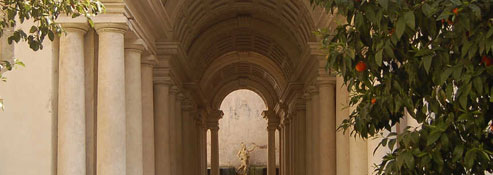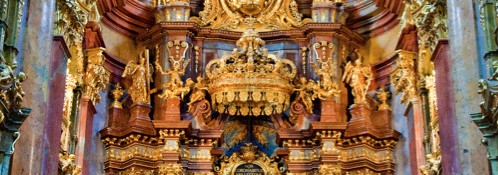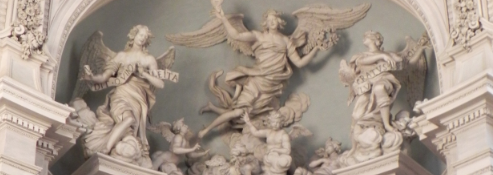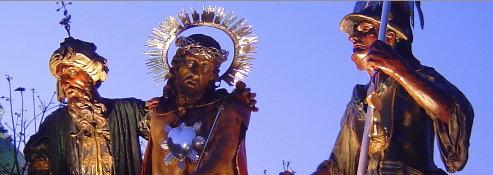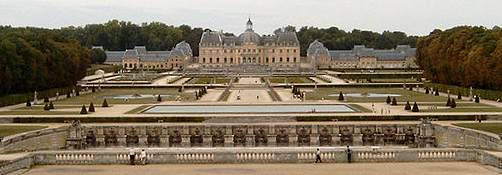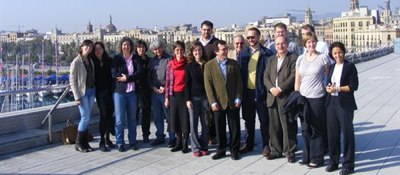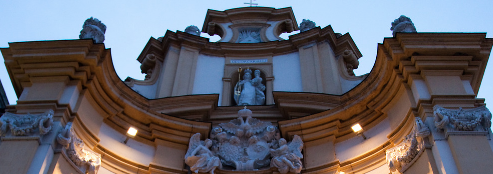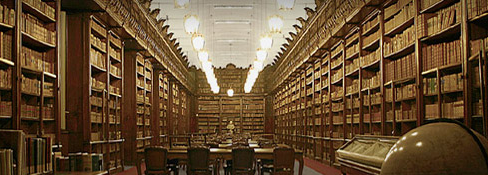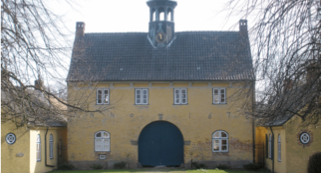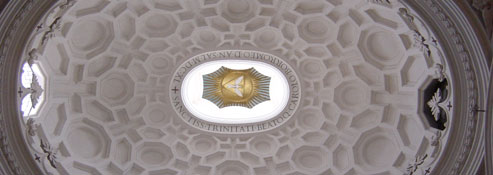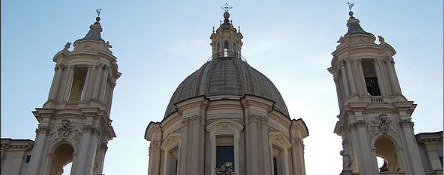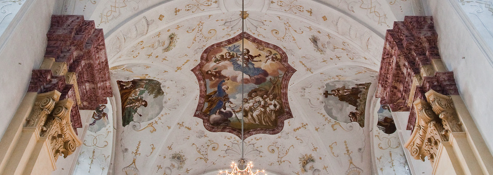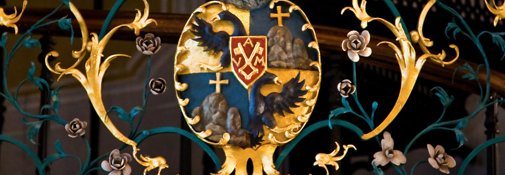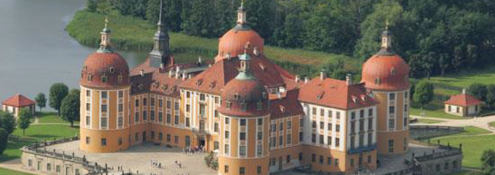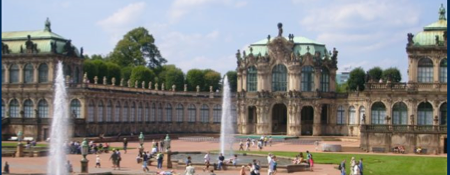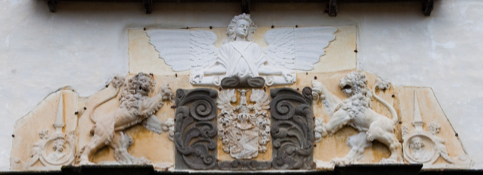During the seventeenth century, attaining and preserving international predominance, in a political space characterised by the complexity and instability of the relationships of power, became a priority for the European states' structures of government. In the service of this goal unfolded an intense political and diplomatic activity, and with it a circulation of people, ideas and works which took on a starring role in the game of power that characterised that political world, in a permanent state of construction, that was seventeenth-century Europe. [1] This process would come to play a part equivalent to the printing press in modern culture, contributing through its activity to the transformation of thought, social activities and the relationships of power [2], while at the same time activating and renewing cultural and artistic relationships.
In this context, the numerous journeys undertaken by members of the European courts, throughout and even far beyond their spaces of power, to attend to the diverse matters concerning the management of the state, would assume a prominence of which we should take note. Often preceded or accompanied by the movement of agents and ambassadors, these journeys contributed to creating a private and public space of immense artistic and cultural exchange, in which the circulation of printed materials would be of great importance, as would the participation and collaboration, in a multitude of celebratory acts, of intellectuals and artists belonging to the entourages of different courts. In these, the construction and exhibition of the image that power presented, as a legitimising element of its aspirations, acquired a special nuance in the field of political communication, becoming a crucial part of the competition between states. [3]
Only ever undertaken for reasons of great political transcendence, these journeys set the courts in motion. [4] They crossed their own borders to ensure their power was manifest throughout the territory, radiating their influence in varied political and geographical spheres, through the presence of awe-inspiring retinues which reproduced the structure of the court. [5] Organised at a time when the model of the stable court was wholly consolidated, these journeys thereby became "a way of doing politics" [6], whose value as an object of study begins with the framework of internationalisation in which they were developed. It was this, ultimately, which created the necessary conditions for diverse models and artistic and cultural customs to find themselves face-to-face, striking up an interesting game of "crossed gazes" [7] in which the key to the creation and interpretation of messages resided. It was, furthermore, this space of international competition which permitted the various powers to achieve, or at least attempt, the articulation of global political discourses, of European dimensions, through the use of words, images and gestures. These were discourses representative of their identity, which would come to generate a visual reality whose spaces, circumstances and protagonists aid our understanding of the use and function of the image in the Early Modern period from a comparative perspective. [8]
The importance these journeys would attain, however - as active agents, instigators of the exchange, creation and circulation of models - cannot be understood without first touching upon another essential ingredient: that, widely explored by historiography, which recognises the role played in the Early Modern period by festivals, ceremonial and etiquette, as complex cultural forms linked to the states' political strategies and, therefore, directly related to the exercise of power. [9] Supported by a foundation of political motivations, such elements would come to form part of these journeys almost by default, becoming "cultural and political actions" where the characteristic communicative and expressive necessities of power converged. These ultimately became an exercise par excellence in propaganda, served perfectly by that which has come to be called the "festive world", composed of a wealth of ceremonial acts which were, for the most part, already well codified in the early seventeenth century. The festivals of the time had demonstrated their nature as a great proving ground on which to test the strategies of prestige against a backdrop of international rivalry. This reality would be accepted, from a historiographical viewpoint, by none other than J. Burkhardt, who, in his work The Renaissance Culture in Italy, alluded to the Italian festivals as occurrences surpassing those of the rest of Europe. [10]
The courts, great consumers of pomp and ceremony, would view these journeys as the ideal stage on which to implement their strategies, plotting routes loaded with significance through the principal spaces where international hegemony was decided. During their deployment would come into play all those communicative codes associated with art and culture which would be employed to achieve a victory quite apart from the war, that is, in a political and social arena where the battle was fought through ceremonial, festivals, new forms of behaviour, the construction of villas and palaces, the zeal for collection, the wealth of individual fortunes and the complexity of the offices of each House. [11] In this process, the journey was no more than a catalyst or channel, facilitating the creation of a deliberate "social space of relaxation", perfectly suited to artistic and cultural exchange, to which gestures, attitudes and art gave form, modulated by ceremonial and etiquette. [12] This explains why the process of exchange among European courts, beginning with the journey's festive dimensions, reached its apex in the context of what have come to be called "rituals of the court", namely those ceremonies involving the king and the upper nobility, where the only other spectators were ambassadors, the representatives of foreign courts and occasional visitors [13], all empowered to interpret and assess the transcendence which etiquette and the artistic image could bestow upon politics. It is not by chance, then, that the Hispanic Monarchy adopted Burgundinian etiquette, among the most lavish, just before Charles V and his son began the celebrated journey which would lead them to tour the European territories between 1548 and 1551. Nor was it coincidence that the Savoys, present in Philip III's court in the early seventeenth century, developed their own etiquette, inspired by that of the King of Spain. [14]
The journey became a political strategy of competition between states, dramatised through festivals. As such, it was widely used by European rulers to create models which would circulate among the diverse centres of power. The majority of these journeys were conceived in the sixteenth century. One familiar example is Charles V's journey to France, between 1539 and 1540, with the intention of dramatising - for all Europe to see - the peace between two Christian nations who had long been enemies but were now forced to unite against the Turk. [15] Others include Charles V and Philip II's journey across European territories in 1548-51; Charles IX's Grand Tour through France to arrive at the Spanish border, in 1564-65; and the journey which Henry III of France made in 1573 - one of great international visibility - from Poland to his motherland, passing through Austria, Germany and Italy. These would be observed with great interest by other European monarchs, generating a growing tendency to exploit these events, integrated into the court's political and social dynamic, as supreme instruments of propaganda.
The first of these - the journey of 1539-40 - was of particular interest to Henry VIII, and permitted the emperor and his court to contemplate many of the works commissioned by Francis I to the greater glory of his dynasty, his nation and his person. Among these were the castles of Amboise, Blois and Chambord, with its spiral staircase; Fontainebleau, including the Gallery of Francis I; and the renovation of the Louvre's courtyard. Even before this, Francis I had impressed the English ambassadors with the reception he offered them in La Bastilla in 1518, highlighting the political effects of what we might call the "culture of the spectacle", other examples of which include the encounter, in 1520, between the King of France and Henry VIII of England, or the well-known meeting between the Spanish and French courts in Bayonne in 1565, where there occurred, over the space of two weeks, a whole array of entertainments (banquets, dances, aquatic games, tournaments and more), which left a profound mark on the participants and which would come to feature in the series of tapestries known as the "Valois Tapestries". The French court also impressed the English ambassadors in 1585, with a creation linked to the French identity: the Ballet Comique de la Reine, with which performance they hoped to establish, through the use of culture, a space of reconciliation between the two countries. [16] Their creations, such as those of the grand royal entrances, would be exhibited before foreign ambassadors, who as spectators would relay information to their respective homelands. [17]
In this sense, for those who undertook them these journeys represented an unprecedented educational experience, a manner of intense immersion course implemented through international courtly culture, whose repercussions remain somewhat opaque to this day. The most relevant example, and the most highlighted by researchers, both for its magnitude and its consequences, was the Spanish court's journey, between 1548 and 1551, through Italy, Germany and the Low Countries, in order to present the future Philip II to the European powers as Charles V's successor to the imperial crown. [18] This became an act of exhibition and propaganda for the Habsburg court's model of prestige, expressed through festivals and spectacle, assembling the most illustrious representatives of the European courts during numerous ceremonial and festive acts understood as the expression of political messages. The event had an unprecedented impact thanks to its international nature, transforming the codes of expression which had heretofore been used by courtly European society, at the hour of its mise-en-scène. The Habsburg model would henceforth be the archetype when it came to putting into practice "territorial, ceremonial and symbolic competition, based on the quest for prestige and reputation", its systems of expression being assimilated, emulated and codified by other European courts - the French included, for Bayonne's festivals of 1565 - in an attempt to capitalise on the communicative success of a cultural and artistic strategy which, suitably adapted, could serve as a propagandist tool for any other dynasty.
In the words of Jonathan Brown, this journey removed the prince and a good part of the court from "their provincialism", internationalising their tastes and spurring artistic renovation through contact with "the things they saw and the people they met" [19] in their travels through Italy, Germany and Flanders. We know that in Genoa, Mantua and Milan the king and his court had contemplated works by Alberti, Bramante, Leonardo, Giulio Romano and Mantegna, in addition to meeting Titian and Leone Leoni in Milan, who then joined their entourage. The monarch also met Antonio Moro, who would become his court portraitist. We know, too, that during his time in the Low Countries he had learned the practical concepts of chorography and cartography, meeting Mercator, Van Deventer and Hieronymus Cock, who, years later, would present the king with a map and plan of the city of Antwerp as a gift for his wedding to Queen Mary Tudor, stimulating the king's passion for scientific geography and detailed city maps, a useful method for the apprehension of a given territory.
In 1554, Philip II journeyed once more to Flanders and then England, this time to marry Mary Tudor, completing an artistic training in which the only country lacking was his great rival, France. The king would send the architect Gaspar de Vega to said country in 1556, with orders to study and report on some of the French monarchy's foremost works (the Louvre, Saint-Germain-en-Laye, the Château de Madrid and Fontainebleau), once again highlighting the European monarchies' contest to exhibit their power via art, through an expressive space which would have included common elements alongside flourishes of differentiation permitting the identification of different models.
In this manner, the journeys undertaken by Philip II and Philip III, in 1598 and 1614, contributed to disseminating the Austrians' practices and ceremonies throughout Portugal, reinforcing an earlier impact on the world of Portuguese ceremonial occasioned by the retinues of the queens who had come to Portugal to marry Emmanuel I and John III: an impact which, in the words of José Pedro Paiva, created what we might call a "grammar of behaviours of the rulers and of the courtly aristocracy". The influence that these journeys had on the Portuguese aristocracy, and the latter's interaction with the sights and spectacles on offer, were unmistakable in the splendid festivals celebrated by Rodrigo da Cunha during his archbishopric of Braga in 1627, very probably inspired either by Philip III's triumphal entrance into Portugal, which the archbishop may have attended personally, or by others he was appraised of while Bishop of Oporto. [20]
All of these events concealed a dialectical relationship between similarity and difference, which must be understood as a communicative strategy interpreted in terms of international competition. Their result was the creation of models and counter-models framed by a space of encounter and exchange, brought into existence by the journey itself, which served to drive comparison, invention, emulation and imitation. These elements would play a fundamental role, creating new cultural and artistic realities through a process of influences in which, based on a common foundation, that of courtly language, diverse realities were "confronted". [21]
When considering the grand celebratory projects developed by the principal axes of power in sixteenth-century Europe, a passing glance at any one of these great journeys would allow us to discover the image of this shared model. Here, the "obligation" to live in luxury, sumptuousness and profusion, in an environment of magnificence, became an omnipresent code, fundamental to a private scenography intended to legitimise the power of the states, and the elites linked to them, in the exterior. This code favoured associated phenomena such as ceremonial, festivals, the wealth of individuals and the growing complexity of courtly etiquette and the offices of each household, all of which became signs of distinction; and, furthermore, those spaces which, like the palaces and residences of the nobility - considered as visible signs of magnificence - then played an essential role in the new codes of prestige particular to the court. [22]
It was against this background that the "game of crossed gazes" emerged: in essence, the meeting and exchange of customs and models. A great many examples are available to us, but the journey undertaken in 1598 by the Austrian imperial court, to celebrate the union of Margaret of Austria and Philip III - travelling from Graz to Madrid via Germany and Italy, with a truly impressive celebratory apparatus - clearly illustrates this form of action. The journey, of which the courts' representatives were warned many months in advance, in an act which was itself a political and propagandist communication [23], was designed to strengthen Philip III's position on the political battlefield of seventeenth-century Europe. [24] Its itinerary occurred in an international setting which brought the Viennese imperial court into contact with those of Madrid and Rome, in the presence of princes, aristocrats and ambassadors of the principal Flemish and Italian centres of power [25]: in total, more than three thousand people, originating from Graz, Mantua, Modena, Rome, Venice and Flanders, whose route towards Ferrara - where Clement VIII would officiate at the proxy marriage - followed a precise itinerary, which included stops at the key residences of the nobility, some of these only recently completed. Displayed in this context of high international representation, these buildings reached the dizziest heights of propaganda as signs of identity. On their way towards Ferrara, the members of the court rested in the palaces of Ostiglia and Reverre, belonging to the Duke of Mantua, and in Genoa - as was only to be expected - in the Palazzo Doria. While passing through Germany, the procession's most illustrious members stayed at the recently completed palace of the Salamanca family, formerly linked to the state apparatus of Emperor Ferdinand I through his minister of finance, building what is known today as the Schloss Porcia, in Spitall, with the collaboration of Italian masters. Alessandro Regini, a member of the procession and protonotary in the service of Ferdinand II, could not help comparing the palace, in a letter addressed to the papal nuncio, Archbishop Hieronymus Matteucci, to the Villa Aldobrandini in Frascati and to other villas near Rome. [26]
The palace came to be, in the context of this ceremonial world which surrounded the great journeys, a means of expression which would effectively integrate itself into the traditions of ceremonial and etiquette [27], generating spaces designed to serve the dynasty's exaltation through a propagandist exercise built upon culture and art. [28] The intervention promoted by the Gonzaga family, in the Galería della Mostra of Mantua's ducal palace, represents the perfect example: conceived as a space of power and ostentation, designed to house the finest pieces of the Gonzagas' collection [29], its renovation was galvanised by the marriage, in 1608, of Francis IV, the duke's son, to Margaret of Savoy. Before this international audience, the duke aimed to exhibit his cultural pre-eminence among the European courts, through his possession of one of the finest collections of the era, which would thus become incorporated into his own ceremonial world. A similar phenomenon would take place, also in the Mantuan court, not too many years later. In this case, the motive was the journey which Emperor Ferdinand II and Eleonora Gonzaga made in 1622, from Mantua to Innsbruck, the Camera dell'Audienzia this time being chosen to showcase the Gonzaga's most outstanding pictorial works, along with other sumptuary objects, jewellery and crystal, signifiers of the court's power. [30] The dynasty thereby reinforced a tradition which had, at the time, already become evident in other palatial residences, also related to the festivals and ceremonial of the great journeys. We might recall, for example, the famed celebrations held in Mary of Hungary's palace during Charles V and Philip II's journey to Binche. Their corresponding spaces of power would be the galleries, filled with paintings of cities, created in some of the key courtly residences of the day, some designed as the setting for grand festivals intended for a public as distinguished as it was international.
Luxury and magnificence, as elements of class identity, would be equally present in the configuration of that common model which European courtiers were able to contemplate in their travels through Europe, surrounded by the ceremonial and festive apparatus which accompanied them. Diplomatic correspondence, and the accounts of these festivals, often concentrated on such aspects, attributing the exceptional nature of the event to the splendour and wealth afforded it by these jewels and sumptuary objects. Luxury and magnificence became, in fact, one of the keys to the competition between courts, as they constituted, as pointed out by Saavedra Fajardo in his Empresas políticas, a form of presenting oneself to the world "with admiration and respect". [31]
The Spanish court would thus employ grandeur and sophistication as a means of demonstrating its political superiority to the English court, during the journey carried out in 1623 by the Prince of Wales (the future Charles I), the Duke of Buckingham, and their associated circle of power. [32] The documentation describing Margaret of Austria's nuptials to Philip III highlighted the cost of the gifts given by princes of the various courts, especially the papal, which for the occasion had requested a loan from the Grand Duke of Tuscany of tapestries and silverware worth 300,000 crowns, also ordering the purchase of golden crowns and crucifixes for those invited to the union, making it clear that this luxury was an "Italian custom" while at the same time an instrument of inter-dynastic and international competition. Luxury thereby became a strategy of prestige inseparable from the public appearance of the class who employed it, creating a physical space which was simultaneously a "social and cultural stage" and a legitimiser of specific practices within the international order. This space would become, through the vehicle of the journey, a source for the creation of models, which would spread and multiply at speed via festivals and spectacle, where the private and public luxury of Early Modern European society, to which Henry Baudillart referred in his Histoire du luxe privé et public depuis l'Antiguité jusqu'à nos jours, would find a place of similarity and of influence with political aims. [33]
Upon this common, shared model, the etiquette and ceremonial associated with the great journeys established a "crossing of gazes" that implied an exposure to difference, essential as an element of reinforcement of dynastic identities, which in many cases offered a unique opportunity to compete for dominance in the international order. The encounters these journeys produced, in the realms of ceremonial and spectacle, brought these courts face-to-face, acknowledging the modifications to the shared model that distinguished them. In this respect we should mention, if only anecdotally, how the events of Philip II and Mary Tudor's matrimonial union in London managed to surprise those present with a bull run, which "was warmly welcomed by all, being something which had never been seen in London". [34] And, in addition, how in the course of these same celebrations, a member of Philip's entourage expressed his displeasure at the frugality with which the festivals had been organised, from the point of view of their ceremonial and decorative aspects, stating that "the celebrations there are all eating and drinking; in other matters they have no understanding". [35]
Of great significance, then, in this space where cultural models collided, was the symbolic importance attached to the moment - in the context of Margaret of Austria's journey to Ferrara in 1598 - at which she, still a princess, removed her German attire to dress a la española before entering Cremona, belonging to the Duchy of Milan and, therefore, a territory of the Spanish Crown. During the same journey, the archduchess Maria, mother of the princess, wrote letters to her son Fernando in which she described, with some distaste, the customs of the Spanish and Italian entourages, which she compared with "the finer state of being of the Germans" [36], going on to criticise the music of Archduke Albert, in whose retinue travelled musicians and singers, among whom there was, according to her, "not one good voice, save that of a sole castrato". [37]
This same "crossing of gazes", in this case between the Italian and German courts, would reach uncharted heights during the journey undertaken by the courts in 1621, between Mantua and Innsbruck, to celebrate the wedding of Emperor Ferdinand II to Eleonora Gonzaga of Mantua. The written account of the celebrations takes on a special relevance, not only because its author highlights their communicative reach: "non ci sono mai visti a Mantova né in Italia", categorising them as "il maggior splendore che habbia havuto mai questa cittá, anzi l'Itaia tutta", but also through its particular emphasis on the international framework in which they were held: "furono spediti dal sig. Duca molti corrieri a tutti i Prencipi d'Italia, e a tutti i potentati della christianità, col darle parte del seguito matrimonio", clearly expressing this reality in certain passages where he indicates how "Entrati dunque nell'amplissimo teatro...da cinquemile persone, la maggior parte forestieri" or how "fu dunque dato principio a la sontuosissima festa con grandissimo concorso di Popolo, non solo della città e stato, ma di forestieri venuti". [38]
The nuptials of Louis XIV to Maria Theresa of Spain were also described - by the author of their most renowned account in Spanish, Leonardo del Castillo - in the same terms of political comparison and competition through the cultural and also, in this case, the artistic. It accented the contrasts between the Spanish and French delegations, who found themselves face-to-face in the pavilion on Pheasant Island, decorated by Velazquez for the international gathering. The author drew attention to the sobriety and elegance demonstrated by the Spanish, in contrast to the pomposity and excess of the French, thereby establishing a comparison of political importance, where the evaluation of the etiquette, fashion or customs of each country became a visible symbol of the contest for political hegemony on an international level, a contest staged through imagery. [39] Whether real or interpreted, intended or forced, difference became the visual key for interpreting models and drawing conclusions. [40]
Cultural traditions, art and ritual thus established the essential cornerstones for the relationships between courts, supported by the use of certain cultural and visual codes in which, it is clear, competition played a crucial part. It was in this process that invention, imitation and emulation exerted their influence. A magnificent example of this is the meeting between the Spanish and French courts in 1615, for the exchange of the princesses Anne of Austria and Elisabeth of France in the "handovers at the Bidasoa". [41] This was a ceremony that acquired a deliberate communicative impact through literature and through art - with a considerable number of accounts and at least four paintings commemorating the event, one created by Rubens [42], dispersed among different courts - through which the Spanish court intended to exhibit its grandeur to the world, making the ceremony a game of appearances with which Philip III hoped, it seems, to dispel rumours of its decline in the exterior. The attention lavished upon the precise definition of the image of each court, brought face-to-face with those of its rivals, gives us a clear idea of the politically communicative dimension acquired by image in the ceremonial and festive space, whose coordinates would determine its use and function. [43]
Its relevance would once more become apparent in the encounter between the Spanish, Italian, German and French languages at the height of the seventeenth century, a result of the struggle between Louis XIV and Leopold I's courts to seize the imperial territories through dynastic succession, via a strategy of matrimonial union. We must remember that in 1660 Louis XIV married Maria Theresa, first-born daughter of Philip IV, while in 1666 Leopold I married Margarita, Philip's second daughter, starting a race for the empire's succession that had major artistic repercussions. The event would be staged in a pivotal space, the international confluence of the seventeenth century's foremost centres for the creation and diffusion of cultural and artistic models through festivals: the Habsburgian of the courts of Madrid and Vienna, the Bourbonic French, and that of Papal Rome, with their respective areas of influence. [44]
The author of one of the accounts narrating Leopold I's marriage to Margarita Theresa in 1668 emphasised the pomp of the celebrations, expressing his admiration in terms of international competition, affirming that "Europe has seen nothing of the kind in centuries". [45] Similar expressions, which attempted to give laudatory prominence to a particular event, and its promoters with it, were frequently employed as a rhetorical resource in the relating of festivals, although in this case the allusion to Europe, and of course the international scope of the event, are of particular relevance to the research context under investigation here.
The extravagance and the spending to which he alluded may very well have been intended, as Friedrich Polleros suggests in his study of the event, to overshadow the nuptial celebrations of Louis XIV and Philip IV's elder daughter. [46] As a result, news of the infanta's journey spread throughout the European courts long before her travels began. The international propagandist nature of the journey is revealed by the preparation of an illustrated description of the festival, of which the emperor would send ten copies to his ambassador in Madrid "para que vos podáis compartirlo con los embajadores y ministros del país, de modo que se difunda un poco por el mundo". [47] It appears that one of these was intercepted by France and later arrived in Madrid without the attached illustrations. These accounts, along with the performance of renowned operas in the Viennese court - the latter similarly promoted - appeared to be an attempt to exalt the prestige of the Viennese court in response to the costly publications of the wedding held in 1660, in Paris, between Louis XIV and Maria Theresa, in addition to the international impact caused by the Carrousell de las Tullerías of 1662, transformed into an allegorical spectacle, in which the king adopted, for the first time, a reference to the sun as his official emblem.
The political intention behind this strategy was none other than a blatant interest in blocking the French succession to the Spanish throne, sending messages of superiority through festivals, "replying" with ingenious alternatives to those sent by the French court through their spectacles. Celebration thus became a means of communication and opposition, of which other courts would have been keen spectators, in a game of counter-models. The ambassadors played a highly active role in this arena, acting as true "artistic agents", halfway between diplomacy and espionage, informing their sovereigns about the actions of the "rival" country. The imperial ambassadors in France, for example, would not have delayed in sending their reports on Louis XIV's representation in the Plaza de Victoires, in Paris, including three paintings of the "reliefs and fettered slaves". The Viennese court's response would be the construction of the Plague Column in 1668. [48]
Descriptions of the Viennese festivals would, in fact, come to form part of Leopold I's official biography, published in Spanish in 1696, a work intended to legitimise the succession to the Spanish Crown through the self-interested description of the relationships between European states. Its publication would become just another part of a "political offensive" channelled through literature and art, encompassing many other interesting moments of equal artistic merit, quite apart from festivals, although it is festivals which interest us here and now.
Around these journeys and their political motivations unfolded an intense diplomatic activity, whose study is of particular interest when researching mechanisms that influenced the circulation of customs and models. We must bear in mind that ceremonial and diplomacy, as much as they were integral parts of the "court apparatus", were at the time responsible for staging the "courtly ethics and aesthetics" [49] in whose mise-en-scène the ambassadors, agents, governors and viceroys were typically involved, being those charged with propagating the monarchy's official image in an international setting. The embassies, therefore, played an important representational role, of increasing interest to historiography, holding solemn ceremonies tailored to the political strategy of a given moment, a form of reconnaissance or trial run for political actions of greater import. [50]
The behavioural manuals for ambassadors abroad made them subject to certain virtues, which had to transcend the realities of states or nations and be "internationally shared". Of particular interest is the fact that they recommended the use of festivals as a political strategy, recognising the potential value that banquets, comedies, music and collection could have in driving cultural development, fostering alliances and permitting artists to scale the social ladder. [51] It was not uncommon for ambassadors and envoys of the various monarchies to maintain an active correspondence concerning these matters. This would include detailed reports of the festivals they had witnessed in foreign lands, offering a magnificent tool to researchers interested in establishing how these were viewed and perceived from diverse cultural and political spaces. After all, the diplomatic language and ceremonial of the Early Modern period shared a common objective and operated on the same principle: that of being instruments of power "understood as a space for practices which sought political results". [52] Both would have been used in the service of international relations of ever-increasing complexity, in a political space where the battle for supremacy became progressively more difficult. The imitation or copying of the political and cultural resources employed by the different courts would prove fundamental to this process.
Through this mechanism, the ambassadors would broaden their international culture, becoming privileged spectators of numerous events, some held in spaces reserved for a select few, while in others a multitude of people and ideas mingled. They were key players in the adoption of courtly customs, such as magnificence, luxury and collection, elements of a well-defined imaginary of prestige, which they incorporated into their own forms of action. Furthermore, they played a highly active role in the ceremonial and festive world, in whose artistic programmes literary and artistic notables frequently took part, these interactions contributing to the formation of cultural and artistic relationships. Their function went beyond simple participation in the diplomatic negotiations preceding the celebrations, or representing the king at weddings, the signing of treaties and other formalities. They requested information concerning the different courts' etiquette, artistic traditions and customs, to be used in the organisation of festivals and ceremonies, witnessing at first hand a festive culture which most likely allowed them to influence such events' decorative programmes, emulating or surpassing the achievements of other courts, as an instrument of political expression in an environment of competition. In fact, the ambassadors came to define ephemeral apparatus with which to make their political ideas realities [53], acquiring a degree of importance which, more often than not, would be followed by exercises in ostentation that led them to promote their own spaces.
The celebrations organised by the Spanish ambassadors in Rome are well known, a strategy to prepare for political negotiations, where the ambassador's residences acquired a special significance. This celebratory activity - of particular intensity - would be practised by other European courts, of which numerous examples are available to us. It suffices to point out the role of festivals in the journey made in 1595 by Vicenzo Gonzaga, accompanied by the imperial troops, styled as an expedition against the Turks in which he attempted to establish himself as the new defender of Christianity. His expedition was remembered as a diplomatic event of great splendour and ostentation, especially the week Vicenzo spent in the court of Rudolf II in Prague, along with the large proportion of the Mantuan court - including Monteverdi, the court musician, and the engineer Gabriele Bertazzuolo - that travelled with his entourage. [54] One of the most splendid acts of his days in Prague was the reception of the ambassadors, "non tanto por la diversità delle persone et de'vestiti loro quanto per la qualità de'presenti, que furono pretiosi e de gran valore". [55] Similarly, during Margaret of Austria's entrance into Ferrara to celebrate her marriage by proxy to Philip III, officiated by Clement VII, the duomo and the house of the Spanish ambassador, the itinerary's key landmarks, were lavishly decorated. [56] In 1615, the Marquis of La Mina, Spain's ambassador extraordinary to France, would create in front of his Parisian residence, located alongside the Louvre on the riverbank, an imaginary landscape representing the union of Spain and France, featuring trees laden with emblems and the shapes of the Ebro and the Seine, illuminating his home's facade with pyramids and chandeliers. [57]
Diplomacy, then, in the processes of negotiating matrimonial ties between different dynasties, would act as an active agent for the exchange of influences between the principal centres of power. The marriage of Philip III to Margaret of Austria, for example, ignited an intense activity between the diplomatic delegations of Rome, Prague and Madrid. [58] In fact, the Spanish ambassador, Antonio de San Clemente, came to Graz to accompany Margaret of Austria on her journey to Spain, coming into contact with princes and ministers from all corners of European diplomacy. [59]
The communicative impact of these journeys and the visual exhibitions associated with them was multiplied by the publishing activity generated in their wake, to the extent that the proliferation and diffusion of these accounts alone would require a monographic study, given their critical importance in the process of the circulation of models. We have already seen the example of the Viennese court, but there were many more, whose relevance is hinted at by the reprinting of works, their translation into different languages or the artistic importance acquired by their publication, in which renowned draughtsmen, engravers and printers all had a hand.
Italy, for example, published versions of the festival celebrating Philip II's union with Mary Tudor in England in 1554; similarly, the narration of Anne of Austria's reception in Madrid in 1571, written by López de Hoyos, acquired a translation into Italian. [60] Margaret of Austria's journey, from Graz to Madrid, inspired more than fifty printed accounts and twenty-five handwritten ones, two of these composed by Lope de Vega. Written primarily in Italian and Castilian, a number were published in French and Dutch, and even translated into English [61], reaching Naples, Rome, Brussels, Valencia, Seville and Madrid [62] . Joannes Bochius would compile, in his Historica Narratio Profectionis et inaugurationis serenissimorum blegii principum Alberti et Iesabellae […], a splendidly illustrated work edited by Cristóbal Plantino, the detailed itinerary of the journey to Italy made by the archduke and archduchess Albert of Austria and Isabella Clara Eugenia. It described the proxy marriage in Ferrara in 1598, in the presence of Clement VIII, as well as their journey to Spain, with an account of their nuptial celebrations in Valencia and another describing the route they followed to their new territories.
Margaret of Austria's entry into Valencia and Madrid saw a German edition published in Brussels in 1599 [63]; her entry into Ferrara was also published in German, in Brussels, in 1598. [64] The event must have inspired great admiration on an international level, as years later, in 1638, an account of the journey was published in the city of Cologne by Johannes Gans, of which a copy remains in the Archivio di Stato di Mantova. [65] In all these celebrations, the arrival of the key characters of the court's political sphere, attracted by the opportunity for political promotion these international gatherings presented, transformed the journeys into important events in both cultural and political life. We must delve more deeply into this topic to reveal, from a new methodological perspective, the significance attained in the sixteenth and seventeenth centuries by certain courtly structures, made visible through a cultural and artistic language whose origins lay in a political action of international importance. This was a language which - as indicated by M.L. Visceglia - this political action was, in turn, able to influence. [66]
Notes
1. This question has recently attracted considerable research activity. See J.M. MARTÍN GARCÍA, La diplomacia en la Edad Moderna: perspectivas para una construcción de la identidad cultural de Europa, en Europa: Historia, imagen y mito, 2008; M. RIVERO RODRIGUEZ, Diplomacia y relaciones exteriores en la Edad Moderna, Madrid 2000; R. SABBATINI and P. VOLPINI, Sulla diplomacia in età moderna: Política, economía, religione, Milan 2012; Arte y diplomacia de la Monarquía española en el siglo XVII, Madrid 2003; L. RIBOT, La proyección de la monarquía hispánica en Europa: Política, guerra y diplomacia entre los siglos XVI y XVII, Bilbao 2009; M.A. OCHOA BRUN, Miscelánea diplomática, Madrid 2012; F. BOUZA, La propaganda en la Edad Moderna española: Medios, agentes y consecuencias de la comunicación política, en Campo y campesinos en la España Moderna. Culturas políticas en el mundo hispano, M. J. PÉREZ ÁLVAREZ, L. M. RUBIO PÉREZ, A. MARTÍN GARCÍA (eds.), Vol. 1, 2012, pp. 281-300; E. CROPPER, The diplomacy of art: Artistic creation and politics in seicento Italy, Milan 1998; T. HAMPTON, Fictions of embassy: Literature and diplomacy in Early Modern Europe, London 2009; R. PORRES MARIJUÁN (ed.), La proyección de la monarquía hispánica en Europa. Política, guerra y diplomacia entre los siglos XVI y XVIII, Bilbao 2009; F. CHECA CREMADES, Del gusto de las naciones, en Las Cortes del Barroco, Madrid, 2003, pp. 17-52; L. BÉLY, Les relations internationales en Europe, XVIIe-XVIIIe siècles, Paris, 1992.
2. R. CHARTIER, El Mundo como Representación. Historia Cultural: entre práctica y representación, Barcelona 1992, pp. 45-62. Concerning the collaboration of the intellectual and the exploitation of culture in the service of the Hispanic Monarchy, see A. QUONDAM, La parola nell labirinto, Rome 1975, pp. 247-264.
3. F. BOUZA, Las jornadas y los viajes reales como fuente para la historia política: Lo público y lo privado en la persona de Felipe II, in Métodos y tendencias actuales en la investigación geográfica e histórica, Madrid 1988, pp. 163-170. L. BERTOLINI and A. CIPOLLONE, Il viaggio e le arti: Il contesto italiano: Atti del convegno internazionale di studi, Pescara 2009.
4. The most frequent were those driven by the constant matrimonial unions, conceived as actions characteristic of the political strategy of the modern state, with the goal of creating, maintaining or extending its spaces of power. Many others (coronation ceremonies, the signing of treaties and alliances and suchlike) were organised as a response to specific political situations. M. MACGOWAN, Dynastic marriages. A celebration of Habsburg and Bourbon Unions, Sussex 2013. K.F. RUDOLF, Tierras europeas de los Austrias. Monarquía hispánica y Monarquía habsbúrgica, in Teatro y fiesta del Siglo de Oro en las tierras europeas de los Austrias. Madrid 2003, pp. 17-25.
5. The descriptions of the journeys and the "travel checklist" often provide valuable information concerning courtly entourages, allowing us to reconstruct the composition of each House. Along with the caballeros and gentileshombres de cámara appeared a considerable number of officials, in addition to musicians, writers, engineers, painters, architects and more. One magnificent example appears in P. BERTELLI, I Gonzaga e l'Impero. Storia de nobiltà e di dipinti, in Atti Acc. Rov. Aggiati a. 256 (2006), series VIII, Vol. VI, pp. 93-149.
6. The study of this area is of interest in furthering our knowledge of the function and organisation of the court as a space of power, as well as the processes by which its political, cultural and artistic models were created. This opinion has been advanced, among other authors, by Ángeles Pérez Samper, for whom "the study of the royal visits contributes to completing our understanding of the court, providing valuable information concerning its organisation and function, in special moments such as the great journeys". A. PÉREZ SAMPER, Barcelona, corte: las fiestas reales, in La fiesta cortesana en la época de los Austrias, Valladolid 2003, p. 1.
7. This expression has been astutely employed by José Luis Colomer in relation to this theme, indicating how "the study of the courts is set out as a political, social and artistic phenomenon of international consequence, more easily apprehended the more it is viewed from a comparative perspective which does not neglect the diverse contributions of the historiographic schools of the twentieth century". J.L. COLOMER, Los senderos cruzados del arte y la diplomacia, in VV.AA., Arte y diplomacia, cit., Madrid 2003, p. 13.
8. This very viewpoint was expressed some years ago by E. Fasano Guarini, supporting the demands of numerous scholars calling for the application of this new method of approximation to the study of courts and states, from a comparative point of view. See Italia non spagnola e monarchia spagnola tra '500 e '600. Política, cultura e letteratura, Florence 2009, p. VI. See also A. PÉREZ SAMPER, Barcelona, corte, cit., Valladolid 2003 p. 141 and C.J. HERNANDO SÁNCHEZ, Familia y lenguaje del poder en la Italia de Felipe II, in Italia non spagnola, cit., 2009, p. 61.
This study, however, constitutes a complex theme, due in large part to the variety and dispersion of the documentary sources available to us, consisting of descriptions of festivities, diplomatic correspondence, embassies' financial accounts and libros de paso. See B. J. GARCÍA GARCÍA, Regalos y consumos suntuarios entre las cortes de Madrid y Bruselas en los reinados de Felipe II y Felipe III, in Ao modo da Flandres. Disponibilidade, innovaçao e mercado da arte (1415-1580), Madrid 2005, pp. 131-155. J.L. COLOMER, Los senderos cruzados, cit., p. 13.
Concerning art and visual culture, see the interesting work La historia imaginada. Construcciones visuales del pasado en la Edad Moderna (J.L. PALOS and D. CARRIÒ INVERNIZZI eds.), 2008.
9. The bibliography covering festivity in the Early Modern period is extensive. From the point of view employed here, see, along with the already classic works of R. STRONG, Arte y poder. Fiestas del Renacimiento, 1450-1650, Madrid, 1988 and R. MULRYNE and M. SHEWRING, Italian Renaissance festivals and their European influence Lewiston, 1992, other works which place the topic in a new research context: that of cultural exchanges. See: Europa Triumphans: Court and Civic Festivals in Early Modern Europe (eds. J.R. Mulryne, H. Watanabe-O'kelly and M. Shewring, 2004; Spectaculum Europæum: Theatre and Spectacle in Europe (1570-1750), (eds. P. Béhar and H. Watanabe-O'kelly), Harrassowitz 1999; Court Festivals of the European Renaissance: Art, Politics and Performance, (eds. J.R. Mulryne and D. Elizabeth Goldring), 2002; H. Watanabe-O'kelly, Court Culture in Dresden: From Renaissance to Baroque, 2002. M. BONNER, The Majesty of the State: Triumphal Progresses of Foreign Sovereigns in Renaissance Italy (1494-1600), Florence 1986. El legado de borgoña. Fiesta y ceremonia cortesana en la Europa de los Austrias, Madrid 2010.
10. J. BURKHARDT, La Cultura del Renacimiento en Italia, Madrid 2004, pp. 342-343.
11. On this topic see W. THOMAS, Símbolos, imágenes, rituales: el lenguaje simbólico del poder en la Europa del Antiguo Régimen in Memoria y civilización, t. 13. Pamplona 2010, pp. 9-33.
12. B.J. GARCÍA GARCÍA and Mª. L. LOBATO, (coords.), Dramaturgia festiva y cultura nobiliaria en el Siglo de Oro. Madrid-Frankfurt am Main 2007, pp. 45-87. F. BOUZA, El espacio en las fiestas y en las ceremonias de corte. Lo cortesano como dimensión, in La fiesta, la ceremonia, el rito, Granada, 1990, pp. 155-173.
13. For the distinction between "ceremonies of state" and "rituals of the court", its implications for establishing codes that structured or ordered the courtly social space, and the promotion of the monarchy's grandeur, see M. J. DEL RIO BARREDO, El ritual en la corte de los Austrias, in La fiesta cortesana, cit., Valladolid 2003, pp. 20-25.
14. -S. FERNÁNDEZ CONTI, La introducción de la etiqueta borgoñona y el viaje de 1548-1551, in J. MARTÍNEZ MILLÁN, La corte de Carlos V, Madrid 2000, pp. 97-115 and 209-224. El legado de borgoña, citing the ballet comique, F. YATES, The French Academies of the Sixteenth Century, London, 1947, ch. III.
15. On the subject of Hispano-French relations between 1519 and 1540, and the journey itself, widely addressed by historiography, see R.J. KNECH, Charles V's Journey through France, 1539-40, in Court Festivals, cit., p. 153-170. C. PAILLARD, "Le voyage de Charles-Quint en 1539-40", in Revue des questions historiques, vol. 25 (1879), pp. 506-550.
16. See LE ROUX, Nicolas, "The politics of festivals at the court of the last Valois", in Court Festivals, cit., pp. 101-1117.
17. This was the case of the English ambassadors, mentioned in the Calendar of State Papers, of the Italian Marco Antonio Barbara, and of the Turkish ambassador, who on his first day in Bayonne ate with Charles IX in the Abadía de San Bernardo. Bibliothèque Nationale de France (BNF), Fondo Antiguo. Ms. Italianos, 1725.
18. A. ALVAREZ-OSSORIO ALVARIÑO, Ver y conocer. El viaje del príncipe Felipe (1548.1549), in Carlos V y la quiebra del humanismo en Europa (1530-1558), Vol. 2, Madrid 2001. With respect to the Felicisimo viaje, see C. GÓMEZ CENTURION, El Felicissimo viaje del Príncipe don Felipe. 1548-1551, in L.A.RIBOT GARCIA (Ed.), La monarquía de Felipe II a debate, Madrid, 2000, pp. 19-40; KOIUER, A, El viaje de Felipe II al "Sacro Romano Imperio, in J. MARTÍNEZ MILLÁN (dir.) Felipe II (1527-1598). Europa y la monarquía católica, VI. El gobierno de la monarquía, corte y reinos. Madrid 2000, pp. 451-46.
19. J. BROWN, Felipe II, coleccionista y mecenas artístico, in Ciudades del Siglo de Oro. Las vistas españolas de Anton Van den Wyngaerde. Madrid 1986, pp. 17-18.
20. This influence could be seen in aspects of etiquette and ceremonial: the creation of the sumilleres de cortina, the use of the colour black in clothing, the adoption of solemnity in attitudes and more. After 1580, it could also be perceived in the form acquired by the grand entrances and in the operational regulations of the Cappella Reale. J.P. PAIVA, Las fiestas en la corte de Portugal, in La fiesta cortesana en la época de los Austrias, Valladolid 2003, pp. 226-227. Also highly influential was the diffusion in Portugal of treatises on princely behaviour, such as Relox de Príncipes (1529) by Fray Antonio de Guevara or the Espejo del Perfecto Príncipe Cristiano (c. 1545) by Francisco de Monzón.
21. We might, here, recall the words of F. Mancini, for whom, as had occurred in bygone eras, [the feste] "furono sempre legate alle particolari condizioni storico-politiche ed al livello umanistico delle corti: il fasto e l'imponenza degli apparati, con funzioni di rappresentanza, erano pretesto di emulazione e rivalitá nella politica dei signori che tentavano con ogni mezzo di attirare al loro servicio le maggiori personalitá artistiche del tempo. F. MANCINI, Feste ed apparati civili e religiosi in Napoli dal Viceregno alla Capitale, Naples, 1968, p. 10. Ver I. ENCISO ALONSO-MUÑUMER, La Fiesta en la Italia española, in Teatro y fiesta, cit., Madrid 2003, p. 44.
22. F. BOUZA, El espacio en las fiestas, cit. and W. THOMAS, Símbolos, imágenes, cit.
23. Archivio di Stato di Mantova (AST). Archivio Gonzaga. Sig. b. 605, cc. 861-86.
24. Concerning the political importance of this journey, see P. VENTURELLI, La solmene entrada en Milán de Margarita de Austria, esposa de Felipe II (1598), in La fiesta cortesana, cit., p. 235. For the itinerary and other details, see T. ZAPATA FERNÁNDEZ DE LA HOZ, El viaje de las reinas austriacas a las costas españolas. La travesía de Mariana de Austria, in España y el mundo mediterráneo a través de las relaciones de sucesos, Paris 2008, pp. 341-365.
25. The courtly processions visited Milan, Venice, Mantua, Ferrara, Genoa, Modena, Urbino and Parma, after departing from Graz and passing through imperial territories in Austria and Germany. These would be joined by the Duke of Savoy, who would arrive in Milan accompanied by his entire entourage, which already included the Spanish ambassador to the court of Prague, the papal nuncio, the Venetian ambassador, Ferdinand II's protonotary, the imperial commissioners, Archduke Albert, the dukes of Mantua and Modena, and the Spanish ambassador to Milan, among others, in J. RAINER, "Tú, Austria Feliz, cásate. La boda de Margarita, princesa de Austria interior, con el rey Felipe III de España. 1598-99". In IH 25 (2005), pp. 31-54.
26. Comparison, which allowed the identification of models and their significance in terms of prestige, represents an interesting element when studying the process of circulation of influences. The palace, situated in the Earldom of Ortenbur, had been the project of Gabriel von Salamanca-Ortenburg, the emperor's minister of finances, who around 1533 set about building a great palace, whose construction appears to have involved Italian architects. The building has also been compared to Prague's Belvedere Palace.
27. M. A. VISCEGLIA, Il cerimoniale come linguaggio politico. Su alcuni conflitti di precedenza alla corte di Roma tra Cinquecento e Seicento, in M. A. VISCEGLIA / C. BRICE, Cérémonial et rituel à Rome, pp. 117-176.
28. The study of international exchange in the interaction between etiquette and the palatial structure is the subject of an ongoing study, in the framework of the project PALATIUM: Court Residences as Places of Exchange in Late Medieval and Early Modern Europe (1400-1700), attempting to unearth the relationship between etiquette, cultural traditions and artistic forms.
29. This intervention was entrusted to Antonio Maria Viani and Peter Paolo Rubens. Vicenzo Gonzaga, il fasto del potere, (1562-1612), R. BRUNELLI (ed.), Mantua, 2012; G. MALACARNE, I Gonzaga di Mantova. Una stirpe per una capitale europea, Modena, 2008.
30. G. BERTAZZUOLO, Breve relatione dello sposalitio fatto della serenissima principessa Eleonora Gonzaga con la sacra cesarea maestà di Ferdinando II Imperatore. Mantua 1622.
31. D. de SAAVEDRA FAJARDO, Empresas políticas. F. J. DIÉZ DE REVENGA (ed.). Barcelona 1988, empresa 31, p. 206.
32. J. RAINES, Tú, Austria Feliz, cit., p. 44.
33. The idea of luxury, made so evident on these occasions, is directly linked - as D. Vaillancourt indicates - to the etymological significance of the term luxus and its relationship to the term fasto, so widely employed in the description of these spectacles. The word luxus is thus understood as "excess in one's lifestyle, splendour, pomp". D. VAILLANCOURT, Prestige et urbanité: le luxe dans la rue, in Le jeux de l'échange: entrées solennelles et divertissements du XV au XVII siècle, Paris 2007, p. 48. Its origins should be sought in the need, displayed by Early Modern period's social elites, to establish a contest to outdo one another in luxury and distinction, understood as qualities linked inextricably to magnificence, and this in turn associated with the upper echelons of society. H. BAUDRILLART, Histoire du luxe privé et public depuis l'Antiguité jusqu'à nos jours. Étiene Giraudias, T. I-IV, 1867-1880. See P. BURKE, Il consumo di lusso nell'Italia del Seicento, in Scene di vita quotidiana nell'Italia moderna. Bari 1988, pp. 169-190.
34. Carta en la cual se da relación de lo que ha pasado en el reino de Inglaterra después que el Príncipe Don Felipe entró en él; embiado por un caballero que se embarcó con el príncipe y pasó con él aquel reino, y que se halló presente en todos los actos que se hicieron, a otro caballero amigo suyo en Salamanca. Cfr. E. BORREGO GUTIÉRREZ, Matrimonios de la Casa de Austria y Fiesta cortesana, in La fiesta cortesana, cit., p. 99.
35. Ibídem.
36. J. RAINER, Tú, Austria Féliz, cit., p. 38.
37. Ibídem, p. 42.
38. The author also describes a dance organised in Innsbruck by the Duchess of Mantua, "que el emperador nunca había visto y al que agradó", as well as another dance, this one "alla tedesca", which also inspired admiration among the Italians. BERTAZZOLO, Gabriele, Breve relatione dello sposalitio, cit.
39. "Ostentaron entrambas cortes su grandeza, previniéndose las mejores galas…Viéronse en los vestidos y joyas de los españoles los colores más modestos, los de mejor gusto…Correspondieron con esplendor y gala los franceses a esta opulencia, vistiéndose a su usanza de quantos ricos adornos cabían en el artificio". L. DEL CASTILLO, Viage del rey nuestro señor don Felipe Quarto el Grande a la frontera de Francia. Funciones reales del desposorio y entrega de la serenísima señora infanta de España doña María Tersa de Austria. Vistas de majestades Católica y cristianísima, señora reyna cristianísima madre, y señor duque de Anjou. Solemne instrumento de la paz y sucesos de ida y vuelta de la jornada, en relación diaria. Madrid 1667.
40. The importance which luxury and ostentation acquired as elements of identity in the court of Louis XIV is well described by the Count of Saint Simon, who emphasised how the monarch "le complacía que la gente echara la casa por la ventana en la mesa, en el vestir, en carruajes y caballos, en edificios, en el juego", making "del lujo un honor". Cfr. S. MARTÍNEZ HERNANDEZ, Cultura festiva y poder en la monarquía hispánica y su mundo: convergencias historiográficas y perspectivas de análisis in "Estudios Históricos. Historia Moderna", 31 (2009), p. 129.
41. Mª. J. DEL RIO BARREDA, Imágenes para una ceremonia de frontera. El intercambio de las princesas entre las cortes de Francia y España en 1615. In La historia imaginada , cit., 2008, pp. 153-184. L. BÈLY, La representación de la frontera en las diplomacias durante la época moderna, in "Revista d'història moderna", 26 (2008), pp. 35-51.
42. Ibídem, pp. 153-155.
43. The cultural exchange between courts brought about by Anne of Austria's union with Louis XIII had interesting consequences. Despite a climate unfavourable to relationships between the Spanish and the French, the use of Castilian saw wide acceptance, as evidenced by the fact that César Oudin's Gramática española, published in 1597, would be reprinted no less than seven times, the last in 1619. The alliance took many Spaniards to France, among them Ambrosio de Salazar, who established himself in Rouen and carried out important work in the diffusion of Spanish literature, publishing bilingual editions of collections of Spanish texts. To this would be added the translation into French of important Spanish literary works such as Guzmán de Alfarache, Lazarillo de Tormes, Diana by Jorge de Montemayor, Lope de Vega's La Arcadia and El Quijote. The subsequent step would be that of the mise-en-scène, through the medium of theatre. M.S. ARREDONDO, Relaciones entre España y Francia en los siglos XVI y XVII: testimonios de una enemistad, in "Dicenda. Cuadernos de Filología", 3 (1984), pp. 201-203.
44. For the relations between the Spanish and Austrian courts through festivities, and the process of cultural exchange, see A. SOMMER-MATHIS, Ópera, fiesta barroca. Teatro de la gloria austríaca. Fiestas en Austria y los Países Bajos, in Teatro y fiesta, cit., pp. 54-67. M. de los REYES PEÑA, Relaciones teatrales españolas y austríacas durante el reinado de Leopoldo I y Margarita de Austria (1663-1673), in J.M. DÍEZ BORQUE, and K. RUDOLF, (eds.): Barroco español y austríaco: Fiesta y teatro en la corte, Madrid, 1994, pp. 59-66; F. OPLI, and K. RUDOLF, España y Austria. Madrid, 1997, pp. 148-149.
45. Cfr. F. POLLEROSS, Entre "majestas" y "modestas": sobre la representación del emperador Leopoldo I, in Las Cortes, cit., p. 151.
46. Ibídem, 154.
47. Ídem.
48. The competition between the French and Viennese courts, contested through art, featured many other interesting moments, which highlighted how appropriated artistic symbols were employed as active elements of political competition. Leopold I went as far as prohibiting the use of French in the Viennese court, favouring Italian instead, and attempting to respond, with his palace of Shömbrunn, to the model of Versailles. Ibídem, pp. 152-153.
49. Regarding this question, see I. ENCISO, La embajada de obediencia del VI Conde de Lemos: ceremonial diplomático y política virreinal, in Roma y España. Un crisol de la cultura europea en la Edad Moderna. Vol. I., Madrid 2007, p. 472. The great journeys provided diplomacy with a suitable space to support or create networks of clients through interaction with the elites of power in an international environment.
50. M. RIVERO, Diplomacia y relaciones exteriores en la Edad Moderna. Madrid 2000, and VV.AA. Historia de la diplomacia española. Madrid 1995.
51. This is reflected, for example, in the instructions stipulated by the Advertencias de Buen Gobierno which were awarded to the Duke of Aurisano. See Discurso para el embaxador Conde de Castro, del modo como se a de gobernar en la embaxada de Roma. Cfr. I. ENCISO, Isabel, La embajada de obediencia, cit., pp. 502-503. A. de WICQUEFORT, L'ambassadeur et ses functions, The Hague, 1681.
52. A. CARRASCO MARTÍNEZ, Vos hablareis este mismo lenguaje· El aprendizaje del lenguaje diplomático por el VII Duque del Infantado, Embajador en Roma (1649-51), in Roma y España, cit., p. 516.
53. VV.AA. Arte y diplomacia en la Monarquía, cit., p. 11.
54. P. BERTELLI, "I Gonzaga e l'Impero. Storia de nobiltà e di dipinti", in Atti Acc. Rov. Aggiati a. 256 (2006), series VIII, Vol. VI, p. 101.
55. Ibídem, cit., p. 123.
56. This decoration marked the wedding of Louise Élisabeth of France to the infante Philip in 1615. Relación de las ceremonias observadas y de las fiestas hechas en la corte de París con ocasión del casamiento de Madame Primogénita de Francia con el Señor Infante Don Phelipe. Madrid, Imp. de la Gaceta, 1615.
57. Ibídem. See also Performativity and performance in Baroque Rome (ed. P. Gillgren and M. Snickare), Stockholm, 2012.
58. See in this context J. RAINER, Tú, Austria Féliz, cit. pp. 31-54, which provides interesting documentary references concerning the diplomatic negotiations involved in this dynastic and diplomatic event, and others describing the members of the entourage.
59. Ibídem, pp. 38.
60. T. FERRER VALLS, Las entradas reales en tiempos de Felipe II: las relaciones hispano-italianas, in Italia non spagnola, cit., p. 190.
61. A briefe discourse of the voyage and entrance of the Queene of Spain into Italy, with the triumphes and pomps and showered as well in the cities Ostia, Ferrara, Mantua, Cremona, Milane and the other boroughes and towns of Italy. See also the account of the Voyage of the Archduke Albert into Almagnei. Wolf, John, London, c. 1599, and M. BONNER, A Year of Pageantry in Late Renaissance Ferrara. Binghamton-New York 1990.
62. T. ZAPATA FERNÁNDEZ DE LA HOZ, El viaje de las reinas, cit., p. 6.
63. Corte Beschrijvinghe vande entree der doorluchtichste Coninghinne Marguarita van Oostenrijck / binnen valenchen. Met het heerlijck tractement ende tryumphe die door bevel van de Majesteyt van Spaengien haren Bruydegom aenghedaen is gheweest. Brussels, Rutgert Velpius, 1599.
64. De gheluckighe Incomste des […] Coninghinne vam Spaengien […] in de vermaerde Stadt van Ferrare. Met di feestelijcke ceremonien […] Beschreven door den Ridder Reale. Overgheset uyt het Italiaens, Brussels, c. 1598.
65. Archivio di Stato di Mantova (ASM), Archivio Gonzaga, 38. Mm46.
66. According to the author "what makes the analysis of the categories of communication truly valuable, in a broad sense […] is its capacity to explain the cultural world which creates and uses them, but without forgetting that, strictly speaking, language is merely a cultural vehicle and not cultural reality itself". VISCEGLIA, M.A., Per una storia del linguaggio político della curia romana. Le istruzioni ai nunzi pontifici a Madrid tra 1592 e 1623, in A.L. CORTES PEÑA, J.L. BETRÁN, and E. SERRANO MARTÍN, (eds.) Religión y poder en la Edad Moderna. Granada, 2005, pp. 217-218.1.



